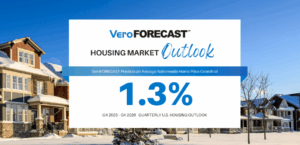Climate change impacts more than the environment, but also where people want to live and the value of homes.
The COVID-19 pandemic’s perceived negative impact on home values was short-lived — the market paused for only one quarter, then resumed appreciating in the subsequent quarters and continues to perform remarkably. Climate change, on the other hand, poses a graver and more long-term threat to home prices.
A recent Lending Tree survey of 2000 participants found that climate change will impact home values and where people want to live. More than 1 in 5 (23%) survey respondents believe homes will suffer damage from floods and storms due to the impacts of climate change.
When asked if they’d consider buying a home in a high-risk coastal zone:
- More than half (55%) said they definitely wouldn’t
- Another 26% said maybe, depending on the home’s location and price
- The remaining 19% said they definitely would
Their caution is certainly warranted. Climate change is already impacting home values in many parts of the country, especially in coastal zones where increased flooding makes building and buying traditional homes less appealing. From property appreciating at a slower rate to the risk of damage from extreme weather to taxes for local resilience measures, property investors and owners have a lot to think about when it comes to coastal property.
A National Bureau of Economic Research working paper in February concluded that homes in flood plains are overvalued by $34 billion because homebuyers don’t fully price in the high risk of climate-related disasters.
Recent research predicts that, by the year 2100, rising sea levels will force about 13 million Americans to relocate from high-risk coastal communities. It’s all part of what some have come to refer to as “the great climate migration.” In the U.S. alone, 13 million people could be forced to relocate due to rising sea levels in the next eight decades. As a result, cities throughout the country will grapple with new populations. Effects could include more competition for jobs, increased housing prices, and more pressure on infrastructure networks.
As the risks of COVID begins to subside, the threat of climate change remains. This threat will be seen in the reality of wildfires, hurricanes and increased flooding. Veros monitors natural hazard activity and provides the post natural disaster property level impact assessment for mortgage lenders and servicers to know precisely which properties are likely to have been impacted. Reach out to one of our disaster data experts to learn more.







